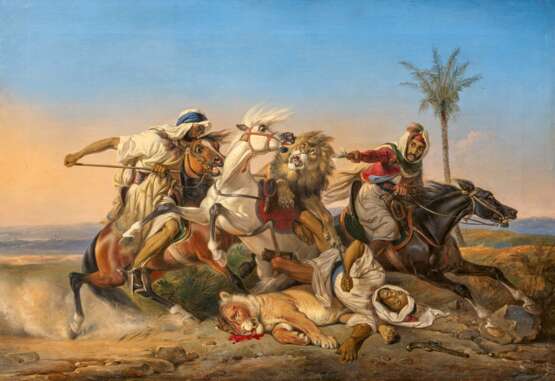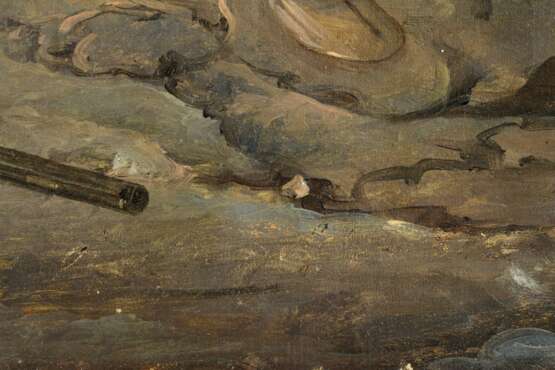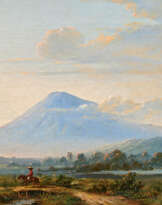ID 1208145
Lot 1159 | Raden Saleh Ben Jaggia. Battle between Arab Horsemen and a Lion
Valeur estimée
€ 300 000 – 500 000
Title: Battle between Arab Horsemen and a Lion.
Date: 1842.
Technique: Oil on canvas.
Measurement: 63.5 x 98cm.
Notation: Remains of the original signature lower right: "Raden Saleh 184(...)".
Frame: Framed.
Verso:
On the stretcher with a later, incorrect attribution to Verestchagen (1842-1904).
Certificate:
Werner Kraus, Passau, 2023.
Provenance:
Private ownership, France.
A wide landscape with palm trees, a deep blue sky in the first warm glow of evening-and below it a wild battle of animals and people intertwined with challenging perspective and almost unparalleled dramatic movement. Life and survival, death and mortal combat are the themes of this extraordinary 1842 painting, in which the contemporary viewer can experience strangeness, wildness and boldness.
Like many other artists of this time of emerging mechanization, Raden Saleh was fascinated by the contrast between the wild and turbulent nature and the anthropized world. In his paintings he shows nothing but the superiority of culture in the struggle against the forces of nature: Be it the large marine paintings with which he established himself in the tradition of his Dutch masters, or the exotic-looking hunting scenes that he painted in Dresden from 1840 onwards. His savage world stood in stark contrast to the sheltered bourgeois system of the 19th century, which tended to create a cosy atmosphere and appealed to the idealised late-romantic vision of the Oriental world. In this way, he attracted even more attention in European society than he had already received as a Javanese prince.
In 1829, at the age of 18, Raden Saleh Ben Jaggia took on the great challenge of travelling to Holland on a scholarship. He wanted to complete his training as a painter, but also to study the homeland of the colonial rulers. Saleh was an absolute exception in the art world of the 19th century.
He stayed in Europe, mainly in the Netherlands and Germany, for over 22 years. His technical skill and flamboyant personality quickly made him a star in a society fascinated by exoticism. The Dresden years, during which our painting was made, were extremely productive and some of his paintings are still privately owned in Germany to the present day. The esteem Saleh enjoyed among his contemporaries is also reflected in the fact that the European aristocracy, including the British royal family, coveted and sought out his paintings. Some of his works can still be found in Buckingham Palace and Windsor Castle, among other places. In his home country Saleh, who returned to Java in 1851, is considered the founder of modern Indonesian art. Raden Saleh thus built a cultural bridge between two then physically and conceptually distant worlds.
The present work, painted in 1842 at the height of his career, brings together the most diverse aspects of Raden Saleh's art: his great model Horace Vernet and his lion hunt painted in 1836, recognisable here, as well as the lion 'Nero', which he saw and portrayed several times in The Hague in 1837.
It is also possible here to recognise his way of working in search of the right expression, which is revealed in the discrepancy between the underlying drawing and the final stroke. The infra-red reflectography indicates preliminary drawings in chalk with varying perspectives and movements or small changes in detail. Raden Saleh literally plays with figures and animals in his work process until he finds his characteristic and powerful composition with fast movements, wide-open eyes and flowing manes.
It is noteworthy that the signature was removed from the painting.
Werner Kraus, the leading expert on this artist, explains in his report that the attempt to remove the signature by the previous owners was influenced by the varied reception of Raden Saleh's work in Europe. While it was the exotic star of its time, it fell into oblivion in the decades of Impressionism and was ignored: a false attribution on the verso of the frame was probably intended to increase its economic value. Today, the remains of the original signature and date are still slightly recognisable with a magnifying glass. They are an important confirmation of this masterly painting, in which Kraus sees one of his major works: "The painting 'Battle between Arab Knights and a Lion', 1842, oil on canvas, 67.3 x 98 cm, is an original work by the Javanese artist Raden Saleh. It was painted in Dresden and must be considered a masterpiece by the artist'.
VAN HAM weaves together with Raden Saleh Ben Jaggia its history as an auction house and a sequence of successful sales: in 2011, we managed to sell Saleh's monumental work 'In letzter Not', also dating from 1842 and depicting an Arabian knight on his grey horse fighting a lion, for around EUR 2 million - for many years the highest auction price for a 19th century painting worldwide.
| Artiste: | Raden Saleh (1811 - 1880) |
|---|---|
| Technique appliquée: | Huile |
| Catégorie maison de vente aux enchères: | Peinture 19ème siècle |
| Artiste: | Raden Saleh (1811 - 1880) |
|---|---|
| Technique appliquée: | Huile |
| Catégorie maison de vente aux enchères: | Peinture 19ème siècle |
| Adresse de l'enchère |
VAN HAM Kunstauktionen GmbH Hitzelerstr. 2 50968 Köln Allemagne | ||||||||||||||
|---|---|---|---|---|---|---|---|---|---|---|---|---|---|---|---|
| Aperçu | |||||||||||||||
| Téléphone | +49 221 92586215 | ||||||||||||||
| Fax | +49 221 92 58 62 4 | ||||||||||||||
| Commission | 32% | ||||||||||||||
| Conditions d'utilisation | Conditions d'utilisation | ||||||||||||||
| Heures d'ouverture | Heures d'ouverture
|









